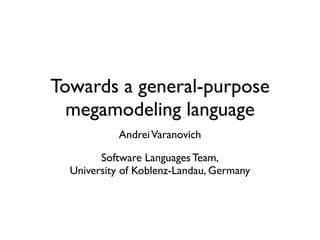Sattose2013 mega
- 1. Towards a general-purpose megamodeling language AndreiVaranovich Software Languages Team, University of Koblenz-Landau, Germany
- 2. http://softlang.uni-koblenz.de/mega/ Work in progress, in collaboration with Jean-Marie Favre, Ralf LÃĪmmel, andVadim Zaytsev
- 3. Colin Atkinson, Thomas KÞhne: Model-Driven Development: A Metamodeling Foundation. IEEE Software (SOFTWARE) 20(5):36-41 (2003) who is Lassie?
- 4. http://en.wikipedia.org/wiki/Lassie http://www.counter-currents.com/wp-content/uploads/2011/10/Lassie.jpg Too many implicit assumptions
- 5. A typical software project programming languages (e.g., Java, PHP, JavaScript, or Python) DSLs (e.g., CSS, XSLT, or SQL) library-based languages (e.g., JQuery, DOM API) conïŽguration languages (e.g., Hibernate mapping) models schemas models âmanyâ languages and technologies âsomehowâ related
- 6. Can we model technologies more precisely?
- 7. Goal: Develop a megamodeling approach that is useful for understanding the linguistic architecture of software products supported by the MegaL language and the tool suite
- 8. âĒmegamodeling must help with managing diversity and heterogeneity of software technologies âĒŅognitive value is important! [Some] motivations: Empirical Assessment of MDE in Industry by John Hutchinson, Jon Whittle, Mark RounceïŽeld and Steinar Kristoffersen use of models for team communication use of models for understanding a problem at an abstract level use of models to capture and document designs
- 9. A megamodel is a model of which at least some elements represent and/or refer to models or metamodels. Bezivin, J., Jouault, F.,Valduriez, P.: On the need for Megamodels. In: Proceedings of the OOPSLA/GPCE: Best Practices for Model- Driven Software Development workshop (2004)
- 10. Ad-hoc megamodel http://en.wikipedia.org/wiki/Tombstone_diagram All relations are implicit Bootstrapping a C compiler written in C, by compiling it using another compiler written in machine code.
- 11. the same information capacity one can deïŽne the same set of instances up to a uniquely deïŽned isomorphism = ? Q: how can we check this?
- 12. The notion of megamodel âĒ Megamodels are (ER) models. âĒ Entities of interest âĢ Languages âĢ Technologies (components thereof) âĢ Programs âĢ ... âĒ Relationships of interest âĢ Conformance âĢ Transformation âĢ ...
- 13. Fig. 1. The linguistic architecture of a software product when displayed with the Me- gaL/Explorer tool. Demo http://worker.101companies.org/MegaModels/implementations/xsdClasses/
- 14. Linked megamodels An entity is linked to a unique resource that can be browsed and examined correspondsTo
- 15. <xs:element name="company"> <xs:complexType> <xs:sequence> <xs:element ref="name"/> <xs:element maxOccurs="unbounded" minOccurs="0" ref="department"/> </xs:sequence> </xs:complexType> </xs:element> http://101companies.org/resources/contributions/jaxbComposition/inputs/Company.xsd/element/xs:schema/element/xs:element?format=html http://101companies.org/resources/contributions/jaxbComposition/src/main/java/org/softlang/company/xjc/Company.java/class/Company?format=html @XmlAccessorType(XmlAccessType.FIELD) @XmlType(name = "", propOrder = { "name", "department" }) @XmlRootElement(name = "company") public class Company { @XmlElement(required = true) protected String name; protected List<Department> department; /** * Gets the value of the name property. * * @return * possible object is * {@link String } * */ public String getName() { return name; } ..... Use of fragments to establish an executable correspondence
- 16. MegaL Design goal: general-purpose megamodeling language https://github.com/avaranovich/megal
- 17. Key design principles âĒ Entities and relationships are extendable âĒ Everything is a resource âĒ accessible over HTTP âĒ Relationships are executable
- 18. MegaL prelude // Entity types Set < Entity . Artifact < Entity . Language < Set . Technology < Entity . Concept < Entity . File < Artifact . Folder < Artifact . // Relationship types elementOf < Entity * Set . subsetOf < Set * Set . partOf < Artifact * Artifact . instanceOf < Concept * Concept . isA < Concept * Concept . conformsTo < Artifact * Artifact . definitionOf < Artifact * Language .
- 19. Some megamodels Java : Language . extern JavaProgram : File . JavaProgram elementOf Java . /* Models, metamodels, and conformance */ Model : Artifact . Metamodel : Model . conformsTo : Model * Metamodel . /* The MVC concept. MVC consists of model, view, and controller. Those subconcepts depend on the main concept. MVC is a design pattern. */ MVC : Concept . Model @ MVC : Concept . View @ MVC : Concept . Controller @ MVC : Concept . DP ["Design pattern"] : Concept . Model partOf MVC . View partOf MVC . Controller partOf MVC . MVC instanceOf DP .
- 20. Design challenges âĒ Many source of (partial) errors âĒ Extensibility of the language, controlled by the type system
- 21. MegaL pipeline event recorder event bus events events events report








![âĒmegamodeling must help with managing diversity and
heterogeneity of software technologies
âĒŅognitive value is important!
[Some] motivations:
Empirical Assessment of MDE in Industry by John Hutchinson,
Jon Whittle, Mark RounceïŽeld and Steinar Kristoffersen
use of models for team communication
use of models for understanding a problem
at an abstract level
use of models to capture and document
designs](https://image.slidesharecdn.com/sattose2013mega-130710063041-phpapp02/85/Sattose2013-mega-8-320.jpg)










![Some megamodels
Java : Language .
extern JavaProgram : File .
JavaProgram elementOf Java .
/* Models, metamodels, and conformance */
Model : Artifact .
Metamodel : Model .
conformsTo : Model * Metamodel .
/*
The MVC concept.
MVC consists of model, view, and controller.
Those subconcepts depend on the main concept.
MVC is a design pattern.
*/
MVC : Concept .
Model @ MVC : Concept .
View @ MVC : Concept .
Controller @ MVC : Concept .
DP ["Design pattern"] : Concept .
Model partOf MVC .
View partOf MVC .
Controller partOf MVC .
MVC instanceOf DP .](https://image.slidesharecdn.com/sattose2013mega-130710063041-phpapp02/85/Sattose2013-mega-19-320.jpg)


